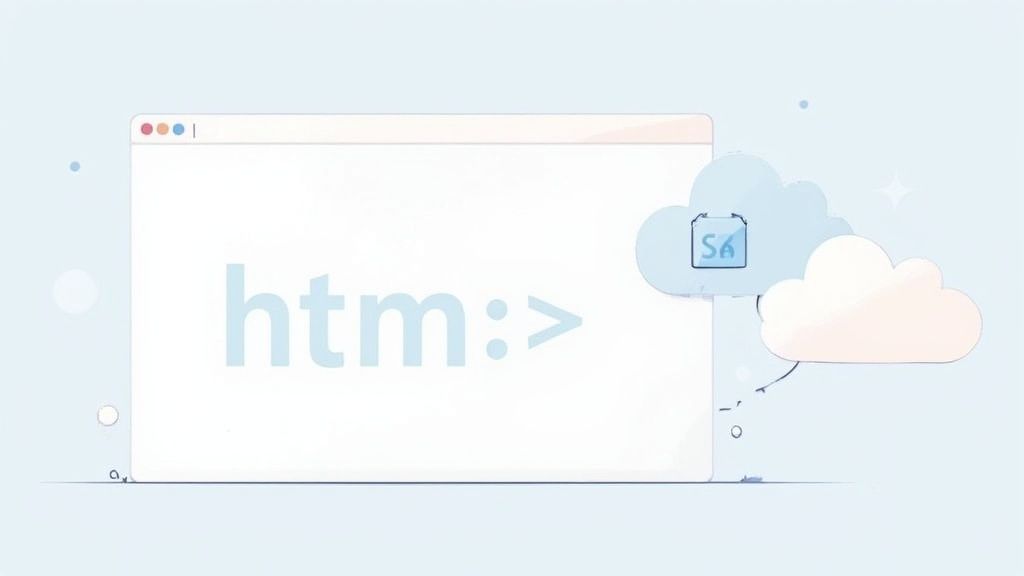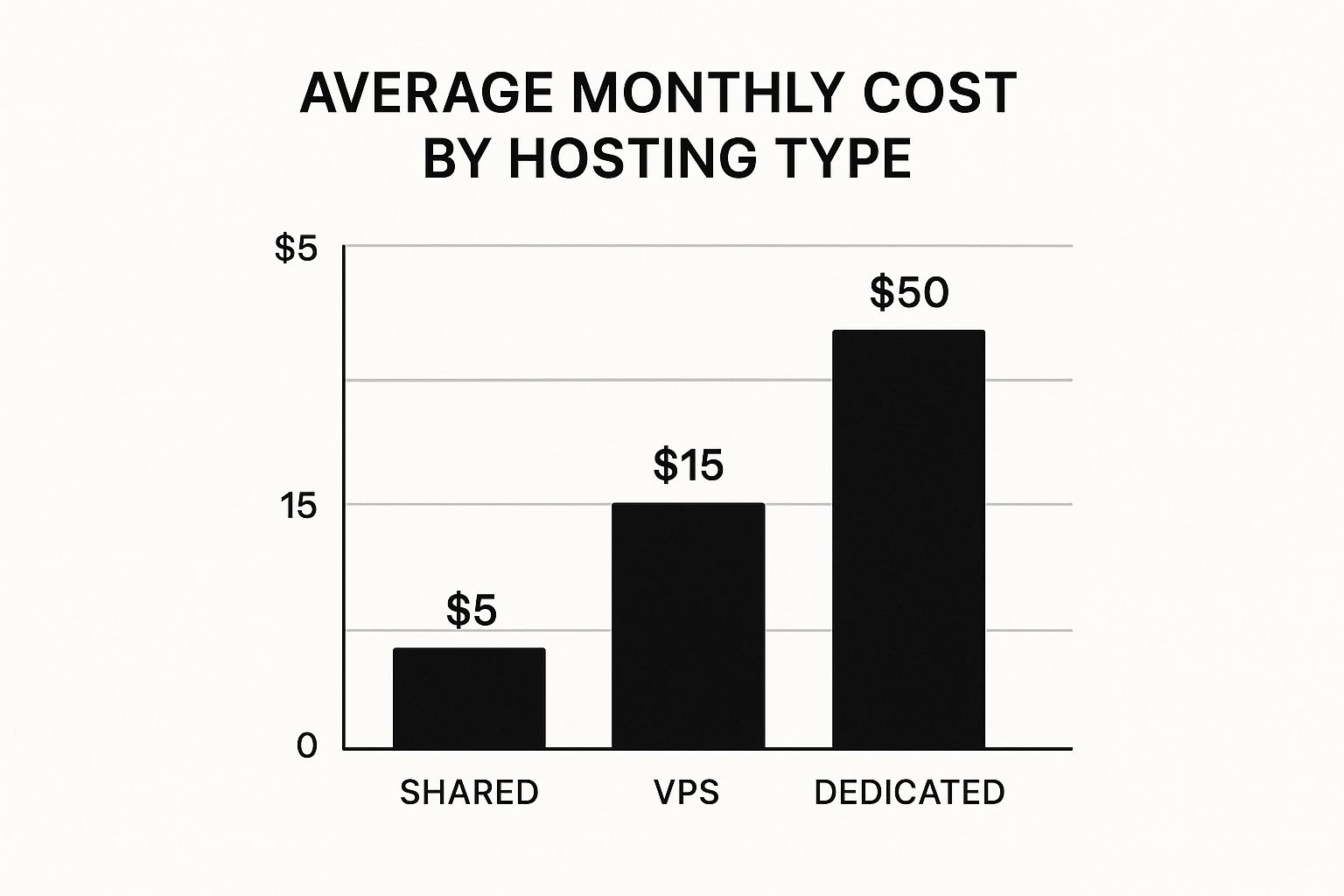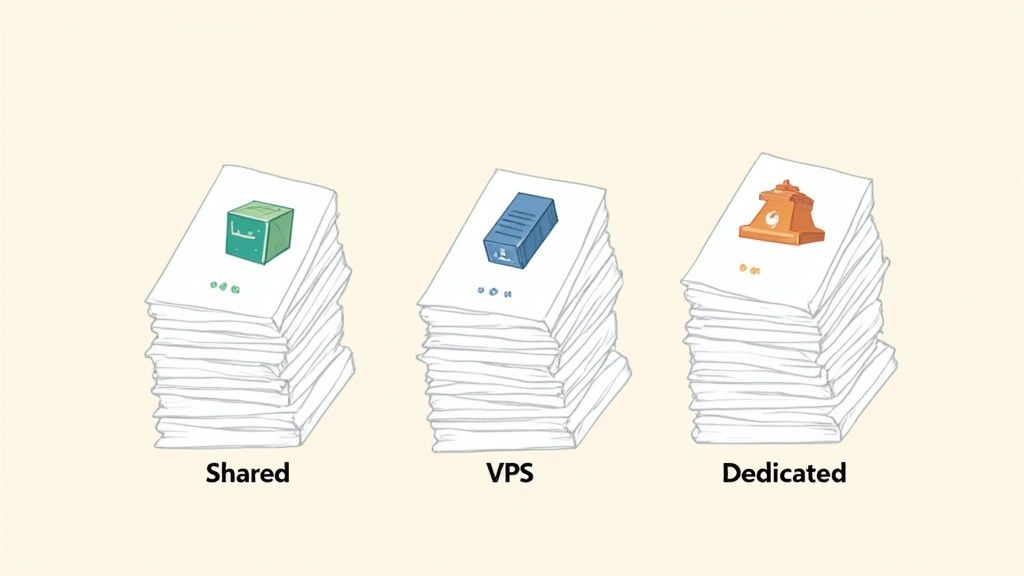HTML Website Hosting Made Simple: Deploy Your First Site

Published : Jul 8, 2025
Written by: Madeson Sykes
15 minutes read
Why HTML Website Hosting Is Your Gateway to the Web

Picking the right web hosting can feel overwhelming. Trust me, I’ve been there. I’ve helped lots of developers launch their first sites, and the sheer number of choices is enough to make anyone’s head spin. But HTML website hosting offers a simple, refreshing alternative. It’s the perfect place to start. You can skip the complicated server configurations and database management and just focus on what really matters: getting your work online.
I’ve seen it happen time and again: Someone starts out completely new to web hosting, and with the help of HTML hosting, they quickly become confident in managing their own site. It takes away the unnecessary complications and gives you just the tools you need. The performance improvement alone is incredible. Because there’s no server-side processing or database queries, your pages load blazingly fast. This stripped-down approach also makes your site more secure because you’re only serving static files.
Reliable web hosting is becoming increasingly important, and the demand is exploding. The global market is already valued at about $103.1 billion in 2023, and it’s expected to almost double, reaching $192.85 billion by 2025. Learn more about web hosting market growth. This growth shows just how vital it is to have a solid online presence these days. In my experience, many developers now choose HTML hosting for portfolios, landing pages, and even entire business websites. It’s that sweet spot between being easy to use and incredibly powerful.
Understanding Your HTML Website Hosting Options
Let me tell you, picking the right HTML website hosting can feel like falling down a rabbit hole. I’ve been there. Free options like GitHub Pages are tempting for personal projects, but they come with limitations. Think restricted custom domains, bandwidth caps, and zero support when you’re in a jam. Premium services often offer way more than a simple HTML site needs, and the price tag reflects that.

The chart above gives you a snapshot of average monthly costs for shared, VPS, and dedicated hosting. Notice the price difference? Choosing the right type of hosting is about balancing your budget with your technical requirements. Then there’s a platform like Href.sh, which is all about simplifying HTML deployment. It cuts out the confusing stuff found in traditional shared hosting, like cPanel and server configurations. I’ve seen developers spend hours wrestling with WordPress hosting for a simple portfolio site when they could have been live in minutes with the right HTML host.
Finding the Right Fit
The perfect host depends on your needs. Traditional hosting can make static sites unnecessarily complex. Specialized static hosting platforms, on the other hand, get it. They understand you just want to host HTML, CSS, and JavaScript without the hassle. If you’re interested in learning more about this, check out this helpful resource: our guide on hosting your own website. Even the market share of web hosting shows this change. Cloud providers like AWS (31%), Microsoft Azure (25%), and Google Cloud (10%) now dominate (as of 2025), proving how important cloud hosting has become for scalable and secure solutions. Want to dig deeper into market share? Discover more insights on market share. The bottom line is to choose what you need, not what the marketing tells you.
To help you get a better feel for your options, I’ve put together this comparison table:
HTML Hosting Options Comparison Compare different HTML hosting platforms based on ease of use, features, and pricing
| Platform | Deployment Speed | Custom Domain | Storage Limit | Best For |
|---|---|---|---|---|
| GitHub Pages | Fast | Limited | Depends on GitHub plan | Personal projects, small sites |
| Netlify | Very Fast | Yes | Varies by plan | Static sites, JAMstack apps |
| Vercel | Very Fast | Yes | Varies by plan | Static sites, front-end frameworks |
| Href.sh | Extremely Fast | Yes | Generous free tier, then paid plans | Simple HTML sites, quick deployments |
| Traditional Shared Hosting | Slower | Yes | Varies by plan | Larger sites, dynamic content, email |
This table highlights some key differences between several popular options. Notice how specialized static hosting platforms prioritize deployment speed and ease of use, while traditional hosting offers more features, but can be slower to deploy. Thinking about what matters most to you will help you make the right choice.
Getting Your Files Ready for the Real World

Before you even think about hosting your HTML website, prepping your files is absolutely essential. I learned this the hard way early on – my first site launch was a disaster of broken images and dead links. Not a good look. File organization is the key. Organize your assets (images, CSS, and JavaScript files) into clearly labeled folders. Just like a well-organized closet, you don’t want to just dump everything in a pile.
It’s like this: if your files are a mess locally, they’ll be an even bigger mess online. Trust me, it’s worth taking the extra few minutes to get organized upfront.
Relative Paths: Your Best Friend
Use relative paths – always. I can’t stress this enough. I’ve seen developers use absolute local paths (stuff like file:///Users/...), which might work on their computer, but will completely break online. Think of it like giving someone directions based on your location; they won’t be able to follow them from anywhere else. Relative paths keep everything linked correctly, no matter where your website is hosted.
Testing Locally: The Right Way
Local testing is crucial, but you need to do it correctly. Open your HTML files directly in a browser, not through a local server. This will reveal any hidden path problems. It’s your dress rehearsal before the big show. Catch those issues now, and save yourself the embarrassment later.
Image Optimization: Don’t Skip It
Optimize your images! Large image files will slow your website down to a crawl. Compress them before uploading. Think of it as packing light for a trip; you don’t need to bring your entire wardrobe. And finally, double-check every single link. A 404 error screams “amateur hour”. A simple link checklist can save you a world of pain. Trust me, these small habits will make your HTML website hosting experience much smoother.
Deploying Your Site With Href.sh Like a Pro
Getting your polished HTML, CSS, and JavaScript onto the web is where the magic happens. I use Href.sh quite a bit and I’ll walk you through the process, pointing out some common pitfalls along the way. First, head over to Href.sh and get an account set up. You don’t need a credit card for the basic hosting plan, which is a huge bonus.
Here’s what the Href.sh homepage looks like:
That clean interface tells you right away that Href.sh is all about ease of use. The drag-and-drop feature is prominent, making uploading a breeze.
Uploading Your Project: Avoiding The First Big Mistake
Uploading your project is as simple as dragging and dropping your files or selecting them from your computer. However, there’s a crucial mistake I’ve seen people make: uploading individual files instead of the entire project folder. This creates a disorganized mess on the server and leads to broken links. Always upload the complete project folder. This keeps your relative paths intact and maintains a clean structure.
You’ll receive a live URL instantly after uploading. Pretty cool, right? Now, the essential part: test everything. Click every link, view every image, and check it out on different devices, especially mobile. A quick mobile test can reveal hidden layout issues.
Custom Domains and DNS: A Timing Trick
If you’re using a custom domain (which I strongly advise for professional work), setting up DNS with Href.sh is straightforward. The key here is timing. DNS changes can take up to 48 hours to propagate fully. Don’t panic if your custom domain doesn’t work right away. My trick is to set up the DNS records before deploying the site. This lets the DNS changes happen in the background while I finalize everything else. Usually, by launch time, the domain is pointing correctly.
SSL Certificates: The Silent Guardian
Don’t forget about your SSL certificate. Href.sh automatically handles this, which is fantastic. It’s still good to know what’s going on behind the scenes, though. An SSL certificate encrypts the connection between your site and the user’s browser, offering vital security. This is especially important if you’re collecting any user data, even just an email address. You can find out more about free static website hosting options here. Href.sh handles the technical complexity for you, making secure sites simple to create. This balance of simplicity and professional features is what sets Href.sh apart in the world of HTML website hosting.
Making Your Site Fast and Secure

So, you’ve got your site live. Fantastic! Now let’s talk about making it really sing. Performance and security aren’t just empty jargon; they have a direct impact on how visitors experience your site and how search engines view it. I’ve learned this the hard way, and trust me, a few simple adjustments can be transformative.
Performance Boosters: Speed Matters
Performance boils down to speed. One of the easiest wins is image optimization. I personally use TinyPNG and have seen load times drop by a staggering 60% just by compressing images. And the best part? There’s practically no noticeable loss in quality. It’s a total game-changer. Another quick fix is minifying your CSS and JavaScript. Plenty of free online tools can strip out unnecessary characters, making your files smaller and faster to load.
Minimizing HTTP requests is another key factor. Every image, script, and stylesheet your site uses creates a separate request. Fewer requests mean a faster-loading site. Consider combining your CSS files and using CSS sprites for smaller images. These small tweaks can make a big difference.
Security Smarts: HTML Website Hosting Advantages
Hosting a static HTML website offers inherent security benefits. You’re serving static files, which means there’s less to exploit compared to dynamic sites. That doesn’t mean you can ignore security altogether. Always use HTTPS, which Href.sh thankfully takes care of automatically. Be cautious with third-party scripts, though. I learned this the hard way when a compromised social media widget injected malware into one of my sites. Ouch. This emphasis on security is driving growth in the web hosting industry, with projections estimating the market will reach over $355 billion by 2029 and about $508 billion by 2032. The demand for secure online services is definitely shaping the future. Find more about the future of web hosting here.
Monitoring for Success: Regular Check-Ups
Regular monitoring is your best friend. Set up Google Analytics to understand your site’s performance and user behavior. Google Search Console is invaluable for identifying and fixing SEO issues before they spiral out of control. I personally check my sites weekly, looking for broken links, slow-loading pages, and any security warnings. These small, consistent checks make a big difference in the long run, leading to a much better user experience.
When Things Go Wrong (And How to Fix Them Fast)
Let’s face it, hosting a static HTML website isn’t always smooth sailing. Sooner or later, you’ll hit a snag. When that happens, you’ll want quick fixes, not a migraine. Trust me, I’ve been there – I’ve seen sites disappear into the digital ether and images stubbornly refuse to load. The good news? Most HTML hosting issues are fairly common and easy to diagnose.
Common Culprits: Where to Look First
Site down? 90% of the time, it’s either a DNS problem (rare with simpler static hosts like Href.sh) or you’ve uploaded your files to the wrong place on your server. Double-check your file structure and make sure your index.html file is right where it should be – in the root directory. Images not showing up? Check the file paths in your HTML. Even a tiny typo can derail things. Page loading slower than molasses? Often, the problem is oversized images, or perhaps you’re loading too many external JavaScript libraries.
Systematic Troubleshooting: A Step-by-Step Approach
When troubleshooting, I like to take a systematic approach. First, check your hosting provider’s status page. Sometimes, the issue isn’t on your end at all. Next, if you have access to other sites on the same server, see if they’re working. If they are, the problem is likely with your specific site. Try loading your site from another device or network. This helps rule out any local problems, like a wonky browser cache. Remember, most hosting hiccups are temporary. A little patience goes a long way, but knowing when to wait and when to start digging deeper is crucial.
My Secret Weapon: The Troubleshooting Checklist
Over time, I’ve developed a simple checklist that covers the most frequent issues. Honestly, it solves the majority of my problems. And if all else fails, don’t hesitate to reach out to your hosting provider’s support. A good provider, particularly one specializing in static HTML hosting like Href.sh, wants to see you succeed. They’re on your team. Everyone runs into problems, even seasoned web developers. It’s just part of the game.
Speaking of troubleshooting, I’ve put together a quick reference table that might help you diagnose and fix some common HTML hosting issues:
Common HTML Hosting Issues and Solutions Quick reference guide for diagnosing and fixing typical deployment problems
| Problem | Symptoms | Common Causes | Solution |
|---|---|---|---|
| Site Down | Website inaccessible, error messages displayed | Incorrect DNS settings, server outages | Check DNS settings with your registrar, check host status page |
| Missing Images | Images not displaying | Incorrect file paths in HTML, file permissions | Verify image URLs and paths, check file permissions |
| Slow Loading Pages | Page takes a long time to load | Oversized images, excessive JavaScript libraries | Optimize images, minimize external resources |
| 404 Errors | “Page Not Found” message displayed | Incorrect file names, broken links | Double-check filenames and URLs, fix broken links |
| 500 Errors | Internal server error message displayed | Server-side issues, faulty code | Contact hosting support, check server logs |
This table covers some of the basics, and hopefully, it’ll get you back on track quickly. Remember, troubleshooting is often a process of elimination, and a little methodical thinking can save you a lot of time and frustration.
Your HTML Website Hosting Journey Continues
Congrats! Your site is live. You’ve officially entered the exciting world of HTML website hosting. But launching your site is just the first step. Think of it like building a house–you’ve laid the foundation, now it’s time to think about furnishing and maintenance.
Backups and Organization: The Unsung Heroes
Seriously, back up your site files. I can’t stress this enough. I have a simple system of dated folders on my computer. It’s not glamorous, but it has rescued me from disaster more times than I can count. Think of backups as your website’s insurance policy.
As your projects grow, staying organized is key. Trust me, when you’re juggling multiple HTML sites, good organization can make or break your workflow. Consistent file naming, a logical folder structure, and even a simple text file documenting any custom configurations can save you hours of frustration down the line. It’s like having a tidy workspace–it just makes everything run smoother.
Performance and User Feedback: The Dynamic Duo
Keep an eye on your site’s performance. User feedback is gold. I’ve learned that seemingly small tweaks to your HTML website hosting setup can have a huge impact on the user experience. And real users can offer insights you’d never think of on your own.
For instance, if your traffic starts to take off, you might need more bandwidth. Upgrading your hosting plan is one option. Or, you might consider using a Content Delivery Network (CDN) to speed up loading times for users around the world. These proactive adjustments can help your site scale smoothly.
Building on Your Foundation: HTML Website Hosting as a Springboard
Starting with HTML website hosting gives you a strong foundation. Whether you eventually move to a more complex setup or stick with static hosting, you’ve learned the essential principles. You’ve taken that crucial first step. Remember when I was first starting out, nervous about hosting anything? Everyone starts somewhere.
Deploying your first HTML site is a huge accomplishment. Keep experimenting, keep learning, and watch your online presence grow.
Ready to experience the ease of Href.sh? Start hosting your HTML website today!